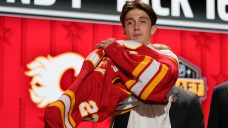The hardest thing about Tom Willander’s journey up draft rankings this season was the final drive to Nashville for Wednesday’s opening round of the National Hockey League entry draft.
It was 11 hours by car from Newark, N.J., to Music City after the Willander family flew from Stockholm to the New York area only to discover their connecting flight to Nashville had been cancelled.
“They offered us tickets to fly on Thursday, but of course that would be a little late,” Erik Willander, Tom’s dad, told Sportsnet in a telephone interview late Wednesday. “It wasn't easy to find a car because most rental cars were gone already. And all the buses were booked out. We tried that. Eventually, we found a car. We drove 11 hours and arrived at our hotel at 2 a.m. this morning.
“We still haven’t received our luggage yet. It’s still somewhere out there.”
Then how was Tom so smartly dressed for the first round of the draft Wednesday night?
“Oh, we bought the suit today,” Erik explained. “Priority No. 1 this morning was to get out of the hotel and buy some suits and new clothes for the draft.”
The Vancouver Canucks were able to help ease the wardrobe crisis by offering Tom Willander a jersey when the team selected the defenceman with the 11th pick.
The fleet-skating 18-year-old, who switched to defence from forward only three years ago, is the first Swedish defenceman chosen in the first round by the Canucks since Vancouver drafted Mattias Ohlund 13th overall in 1994.
Ohlund went on to play 909 NHL games, 770 of them for the Canucks, and is now on the Ring of Honour inside Rogers Arena. The Sedins’ jerseys hang above Ohlund’s image.
Willander met one of the Sedins at a hockey tournament when he was little. He doesn’t know if it was Daniel or Henrik, but may figure it out next week when he attends the Canucks’ development camp and steps on the ice with the twins. The Hall-of-Famers are now key members of the Canucks’ player development staff.
The Sedins, Tom said, are why he became a fan of the Canucks while growing up, and why Wednesday was so special to him when Vancouver general manager Patrik Allvin, another Swede, called his name from the stage to become part of his boyhood team.
“It means a lot,” Willander said. “I'd say (it’s special) mainly because the Sedins being probably the most dominant pair of players to ever play the game, them just having that history. I feel like it's just really cool to be able to play for the same team.
“When I was very young, that was my first team that I ever started cheering for. We used to pull up the NHL game recaps at the breakfast table and I always used to watch the Vancouver Canucks. So, I guess I'm back at it.”
Willander was born in 2005, shortly before the Canucks and Sedins began to rocket upward, and was 13 when the twins retired.
“I really liked them when I was young, when they played,” Willander said. “But I also thought that the logo was super cool. I remember thinking that. It was very nostalgic when I saw the logo up on the big screen (inside the arena in Nashville).”
Willander's encounter with Danny or Hank came at a minor hockey tournament in Ornskoldsvik one summer “up north in the Swedish countryside.” The Sedins handed out trophies in their home town.
Willander came out of the woods this season, emerging over the winter as one of the top defencemen available in this year’s draft. He was the third blue-liner chosen on Wednesday behind only Austrian David Reinbacher (fifth to Montreal) and Russian Dmitri Simashev (sixth to Arizona).
The six-foot-one, right-shot defenceman had a solid draft season with Rogle BK’s junior team but surged to prominence in a starring role for Sweden at the Under-18 world championships. Rogle actually wanted Willander to play on their Swedish Hockey League pro team, but the teenager wanted to remain eligible to play college hockey in the United States, which he will do next season for Boston University.
Erik Willander, who manages and coaches a youth-hockey club in Stockholm, said his son is still just learning to play defence after switching from forward with AIK’s Under-18 team. He moved to Rogle’s U20 team for this past season.
“He played some defence before but not that much,” Erik said. “But the first year after the change, he didn't actually play, really, any games because of COVID. So he's actually only played two seasons as a D. That's also why he focussed so much on the defensive side, especially the first year he played. It's only this year he has really started working on the offensive side of the game, which has lagged behind a little for obvious reasons. But he's only 18.”
Willander is considered one of the smoothest skaters in the draft. He uses his speed and agility to maintain tight gaps on opposing forwards and projects at the NHL level as a defenceman who can be deployed in a shutdown role. The player and his new team believe he has untapped offensive potential.
Rogle’s Canadian general manager, Chris Abbott, told The Athletic before the draft: “The kid can skate for days. He’s a really, really strong, efficient skater. That combined with his aggressiveness, defensive ability and details that he has, he projects to be a really good pro hockey player.”
“Everyone talks about the skating which, of course, his skating his fine,” Erik Willander said. “But I think he's a very good decision-maker. Making decisions under pressure and reading the next play, I think that's actually his best quality.”
The defenceman is intensely focussed, his dad said. Willander chose the NCAA over the SHL for development purposes and to start the transition to North American hockey.
Sportsnet analyst Sam Cosentino said on Wednesday’s broadcast that Willander is “as serious as a heart attack.” In a good way.
“One hundred percent I see myself as a very driven person,” Willander said. “I have a very, very high focus on making the NHL.
“I want to be someone who really plays a big role in the game — the tough games. I want to be a two-way defender, someone who plays a lot of ice time, someone who's good defensively but also offensively, can be put on ice in really any situation. And someone who can win championships.”
Asked about trying in two or three years to play amid the unyielding glare of a Canadian NHL market, he said: “It's high-risk, high-reward. But I like the reward part more than the risk.”
Allvin said Canucks scouts have liked Willander since the start of the season. The player said he felt an instant connection to the team when he was interviewed at the scouting combine in Buffalo earlier this month, then went out to dinner with Allvin, assistant GM Derek Clancey and mental-performance coach Alex Hodgins.
“I feel like there was pretty much a connection from the start,” Willander said. “The general manager being Swedish, I felt like we could speak in a way that I maybe wouldn't be able to with North American folks. I just feel like it was a really good dinner — a spark of a connection between me and the staff there. I had a good feeling about it.”
“It's completely unreal to see this actually happening,” Erik Willander said. “You can't really grasp it.”








COMMENTS
When submitting content, please abide by our submission guidelines, and avoid posting profanity, personal attacks or harassment. Should you violate our submissions guidelines, we reserve the right to remove your comments and block your account. Sportsnet reserves the right to close a story’s comment section at any time.